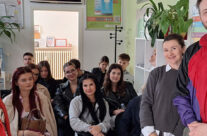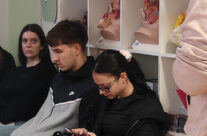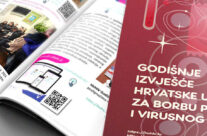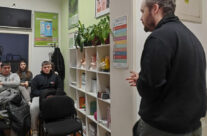
Representative of the CAHIV participated at the International AIDS Conference, from which we bring you a summary of global fight against HIV / AIDS with the aim of creating AIDS free generation and bringing the disease to zero.
Washington, DC, 07/21/2012-07/27/2012
RESEARCH NOVELTY
Novelty in HIV/AIDS research is how do you combine behavioral and biomedical research. The goal of this approach is to reduce incidence of HIV. So far, a unique solution in how to combine these two distinct approaches hasn’t been found. It is assumed that this direction will boost prevention efforts.
TURNING THE TIDE AGAINST VIOLENCE
Almost half of the PLWHA in the world are women. Violence has contributed significantly to the continued spread of HIV. In Africa, women are exposed to relationship violence, and to violence within the health system. What is lacking are violence prevention programs which would address specific needs of risk populations. But beforehand, It is important to find out their understanding of the problem and to highlight impediments to the usage of health services. The problem seems to escalate in countries without democracy, where police violence makes an additional problem for risk groups. Violence creates psychological pressure on persons at risk, increasing vulnerability and making reach impossible. Measured correlation is: higher the violence, lower the usage of services.
ORAQUICK IN-HOME ORAL HIV TEST
This in-home test will empower people to take the first step in learning their HIV status. It will be available in October 2012 in USA. It will be possible to purchase it online as well as in mass-merchandise and drug stores. Live support will be available 24-hours a day, seven days a week, every day of the year thru a telephone line. In addition, a comprehensive website will be launched to provide access to resources and referral to follow-up counseling and medical care. More information will be available at www.oraquick.com
CHALLENGES OF CAREGIVING
One of the largest challenges is care for orphans. In South Africa, the GP approach is under pressure, so care is provided by women organized in HGOs that tend to be funded from abroad. They often experience burnout and are unfortunately exposed to violence. In Amsterdam, experts are concerned with a „skipped generation household“, where a household lacks „middle“ generation, putting the burden of HIV on the „old“. A research in Africa investigated a psychosocial impact of caregiving on 250 siblings of infected children. 98% of them were caregivers (average age 14 years) to an HIV positive child (12 years old on average). Most feel sad, scared and anxious when their sibling is ill, but also 25% of them are under stress, afraid they will get infected, and are worried they will suffer secondary victimization. 16% isolate themselves due to self-stigma („They think we are all positive.“)!
HIV AT 50+
„Someday you will be old!“
People living with HIV will experience old age. The question is what sort of elderly life they can expect. Very soon, Eastern Europe will have more than half of people living with HIV above 50 years of age.
Some of the problems people living with HIV above 50 years of age face are: lack of vitamin B, heart failure without previous cardiac problems, osteoporosis, cardiovascular diseases, lipodystrophy, elevated cholesterol, kidney stones, cancers, cognitive dysfunction, dementia, delirium, depression, suicidal tendencies and more. The question remains which problems arise due to medication, and which are the consequences of weakened immunity.
Starting with the highest incidence this is the list of top 10 problems: 1. bacterial pneumonia, 2. fractures, 3. myocardial infarction, 4. cancers, 5. peripheral vascular disease, 6. diabetes, 7. osteoporosis, 8. liver disease, 9. kidney disease, 10. pancreatitis.
When we look at disability, frailty and functional status, there are three geriatric issues that cover overall health problems. Combined with HIV, viral hepatitis, alcohol, smoking and drug use, issues are cognitive dysfunction/dementia, organ failure, and repeated hospitalization. It is important to emphasize that HIV is not in a vacuum, and that there are other factors that deteriorate health in old age. As far as cancers are concerned, there are two phenomena: that of cancer occurs earlier than the rest of the population or that of cancer occurring at the same age, but more frequently to those living with HIV.
For those who’ve been on therapy during their lives, if they have taken more than 5 drugs, risk of adverse drug events is 10%.
An additional challenge seems to be prevention. In the US alone, above 50, 84% of men and 62% of women reported sexual activities in the last year. The challenge is how to educate and approach this population.
If we focus on the future, those above 65 are still a mystery. The fact is that the relationship between health and ageing is not linear, and that above 65 years of age we can expect drastic increase in brain strokes. This has been demonstrated by a cohort in Switzerland, but so far we obtain too few data to reach broader conclusions.
One presenter at the session from Canada shared his story and demonstrated how people with HIV older than 65 live. He said he’s been positive for 30 years, and that now he spends his weeks going to constant screenings, mainly osteoporosis, cardiovascular diseases, cancer and cognitive dysfunction. He emphasized that among his cohort, problem of great depression episodes is widespread, and that it has a major impact on physical health.
Mental health issues that need to be addressed with this population are most due to social isolation. They are consequences of uncertainty and stigma, especially MSM. Psychosocial programs for those living with HIV above 50+ are essential.
Additional problems are stigma and discrimination in the healthcare system. Until now, resistance towards HIV patients has been reserved to cardiac specialists, surgeons and dentists. We anticipate with trepidation what will occur in those areas of medicine who have had the least to do with HIV/AIDS, which will happen for sure because the patients are getting older.
A lady from Kenya (age 55, liv8ing with HIV for 30 years) emphasized that the biggest problem for women above 50 is that those women are still sexually active, but there are no prevention activities for them. Women with HIV get menopause earlier. In addition to this problem, she also has heart disease that is a consequence of ARV treatment. Personally for her, the biggest problem is to go to her rural clinic in Kenya and ask for condoms. The prejudices towards mature women are huge.
A gentleman who is 65 years old, MSM, demonstrated what kind of a life he has. He said he takes 14 pills in the morning and 11 in the evening. He had two hip replacements, problems with heart and cardiovascular system. But his biggest problem remains his face that is starting to look like a skeleton.
Feel free to find more personal stories on The Graying of AIDS:
DISCRIMINATION IN EGYPT
PLHIV in the Arab world are haunted by the perception that they deserve it. They remain isolated in the society which treats them as criminals. The “Forum to Fight Stigma and Discrimination Against PLHIV in Egypt”, a coalition of 16 NGOs and PLHIV, was created in 2009 with the idea of gathering experts that will provide care for PLHIV. Their specific problems are that they cannot apply advocacy from other parts of the world in Egypt. They cover the following areas: self-stigma, healthcare, workplace, religious leaders, state, and family. The greatest issue is HIV disclosure to family. A lot of them are forced to leave homes, and then they don’t take therapy, due to great self-stigma. Taking ARV in public places reduces compliance significantly.
Media avoid reporting about HIV. Only tabloids do, and they depict HIV as immoral behavior, using stigmatizing language, off-context, along with frightening images. And so, HIV/AIDS remains limited to IDU, SW, MSM and promiscuous persons.
National laws allow mandatory testing as a requirement for obtaining a job, even if someone suspects that a person belongs to the risk population.
As far as family is concerned, it is easier to disclose a status to a friend than to a member of a family. Meanwhile, family gives support to men living with HIV, but not to women living with HIV. Women do get HIV from their husbands most often, but the community condemns them stronger than men.
STIGMA – BREAKING THE SILENCE
In Africa, self-help groups have a beneficial effect on self-stigma. Those who go to self-help groups don’t have a need to disclose their status to their partner. The whole problem comes down to women and areas that consider HIV as shameful.
This reflects on internal stigma, because of which women feel shame, they blame themselves, blame others, feel like they’d been punished, have low self-esteem and are suicidal.
It has been shown that social support partially mediates the relationship between stigma and quality of life, which portraits social support as one of the factors through which stigmatized persons make up their psychological resources. It should be emphasized that 2/3 of this sample demonstrate symptoms of moderate to great depression.
Throughout the world the following programs to reduce stigma are conducted: media work, marking important dates and campaigns focused on stigma. A research in Thailand made field research (door to door) that identified two drivers of stigma in general population: fear of transmission through social contact and values that drive stigma. Then they investigated the impact of knowledge, personal contact (contact hypothesis) and campaigns on stigma reduction and the following results were obtained. Knowledge reduced fear and shame, contact reduced fear, but not shame, and campaigns are able to reduce both under conditions that they are conducted door to door, due to direct contact with person.
AIDS FINANCIAL CRISIS
In the last few years all sectors have been hit by global financial crisis, including HIV/AIDS. By analyzing thr money flow in the world, the future strategy of The Global Fond will be to raise funding from Brazil, Russia, India, China. Also, USA is looking for new way to cut down drug prices of pharmaceutical companies, which would increase access to treatment.
Author: Latica Mirjanić, mag.psih.
Croatian association for HIV and viral hepatitis

















